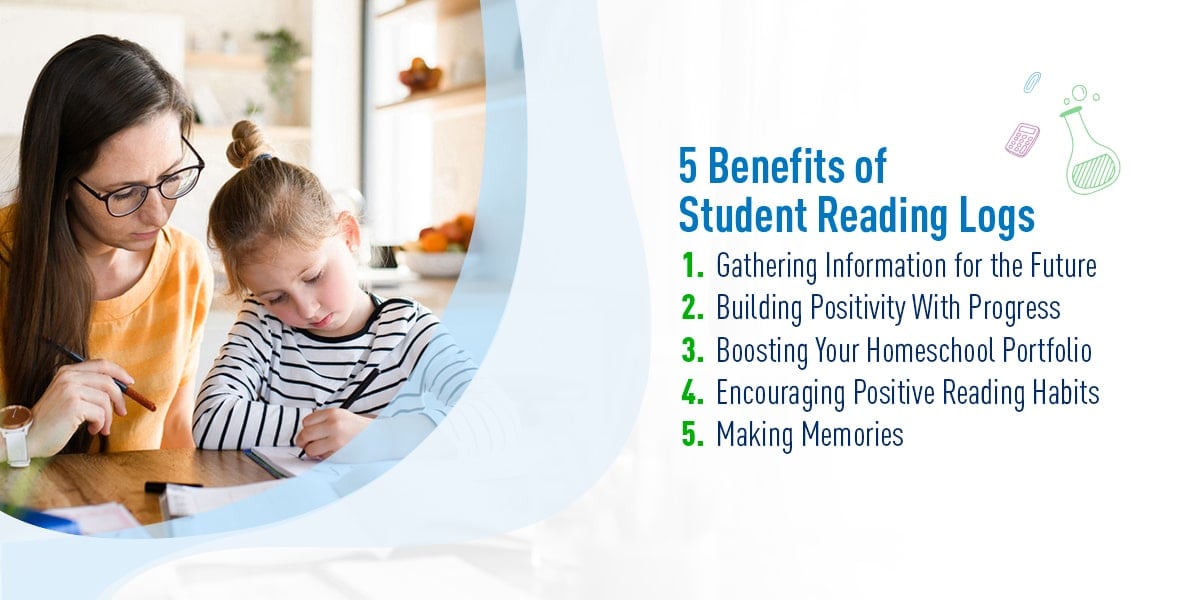As a parent, you know how important it is to help your child develop positive reading habits. Creating a reading log for homeschooling can be a valuable tool to get your child enthusiastic about reading.
We all know some kids love reading and some would rather do anything else. One of the best things about reading logs is you can create them to appeal to every kid. You can ignite a passion for literature, create a reward system, and meet state homeschooling requirements.
What Is a Reading Log?
A homeschool reading log is a method of tracking reading. There is no set structure — that’s one of the best things about it. You can make your reading log as straightforward or detailed as you like. The key is to decide what information will help your child the most. You might only include author names and titles in your reading log, or you may expand it to include reading dates, publishers, notes and reflections, genres, pictures, and ratings for each book.
You can keep a reading log online or in a spreadsheet, notebook, or journal. Reading logs do more than record your child’s completed books — they can help your child set and achieve goals and measure their progress, which makes them feel proud and accomplished.
Why You Should Keep a Homeschool Reading Log
As a homeschooling parent, we understand that you already have a lot on your plate, and you might be wondering why you would want to add another task to your ever-expanding list. The truth is, there are many reasons to keep a student reading log.
In some states, it’s a legal requirement. In these cases, it makes sense to turn it into a project you can enjoy. Check your state homeschool laws to see if you need to make and keep a reading log.
Even if keeping a reading log isn’t a requirement in your state, there are still compelling reasons to make it a habit. For example, your child can use their reading log to build concentration or become more confident branching out into new genres and subjects.
Reading logs are also an excellent way for your child to keep track of their goals. They give you a practical method to assess reading progress regardless of age. They’re also sentimental. As your child grows up, you can look back and see how their choices and preferences have changed and enjoy the memories of all the time you spent reading together.
5 Benefits of Student Reading Logs
While a reading log for kids may seem like a one-dimensional document, there are many benefits to making it a homeschool habit. Some of the many advantages of keeping a reading log include the following:
1. Gathering Information for the Future
As you progress through your homeschooling journey, the more information you have, the better you can help your student along in their academic journey. In the short term, you can reference your reading log to avoid duplicating titles or genres and revisit some of their favorites when they need something familiar.
If you have more than one child to consider, you can use your older child’s reading lists to help make decisions for your younger kids. You’ll have a record of books they enjoyed in the past — and knowledge of the ones they didn’t like.
2. Building Positivity With Progress
As you fill in your reading log, your child gets concrete proof of their progress, boosting their self-esteem and giving them a well-earned sense of achievement. Seeing their achievements build up gives them confidence in their reading and excites them to start their next book.
3. Boosting Your Homeschool Portfolio
Whether your reading log is a state requirement or not, keeping one every year marks your child’s progress, which is an excellent addition to any portfolio.
4. Encouraging Positive Reading Habits
Filling in a reading log can become a habit, encouraging your child to make reading a habit they’ll carry for the rest of their life.
5. Making Memories
You’ll spend countless hours reading with each child, making memories through good literature. You’ll fall in love with different characters, laugh and cry together, and when your child is grown up, you can relive those special moments through your reading log.
Creating Reading Logs According to Grade Level
A reading log can be a valuable tool at any stage in your child’s education. The following tips can help you create a reading log your child will love to use, regardless of where they are in their school journey.
Tips for Creating an Elementary Reading Log
During the elementary school years, you can focus on building strong reading habits. Use the following tips to take your elementary reading log to the next level:
- Use color: Elementary school kids will appreciate a fun reading log. Think about how you can make filling it out more fun using color and pictures. You could rank books green for good and red for bad, for example, or have your child draw a picture that represents each book.
- Create reading-based activities: You can add depth to a reading log with supplementary activities, like writing a letter to a favorite character or interviewing the bad guy for a newspaper.
- Choose the correct format: Think about what design of reading log your child will engage with the most. If they love being online, a digital format might be the best fit, but if they love art, creating a poster could be a better way to keep them interested.
Tips for Creating Reading Logs for Middle School
As your child grows, they start making more decisions about what they prefer to do with their time. You may have to rethink your approach in middle school to make reading one of those choices. Keep the following tips in mind to keep the reading passion burning:
- Create reading challenges: Getting stuck in a reading rut is easy. Creating some well-thought-out challenges can help push your child out of their comfort zone, like reading a book from a different genre or writing both a good and bad review for the same book.
- Memorialize your progress: At the end of the school year, photograph your child next to the pile of books they read that year. Print and frame it as a celebration.
- Incorporate some geography: Create a “books around the world” challenge by printing a map and marking down where each story took place or the author’s nationality. A reading map is a great way to help your child learn about different places and cultures.
Tips for Creating a High School Reading Log
Their high school years offer students a chance to explore their love of reading and how it can spark creativity. The following tips can help bring a new dimension to reading in the pivotal years of school:
- Revisit the classics: Create a separate reading log for classic novels and challenge your child to explore books that have withstood the test of time.
- Delve deeper: Instead of a reading log, consider encouraging your child to keep a reading journal, so they can explore book themes, character arcs, and plot developments.
- Focus on history: Similar to the middle school reading map, you can bring some history into your reading log by focusing on books from pivotal moments in history, like World War II or the French Revolution.
Enrich Your Homeschool Journey With Bridgeway Academy
Creating a reading log is one small part of the homeschool journey. It’s challenging and rewarding at the same time, and with the right team behind you, it can be one of the best parts of your child’s life.
At Bridgeway Academy, we understand and celebrate that each family and child are unique. We partner with over 40 curriculum providers to find the best fit for your child. Enroll your child today, and join a community of teachers and families who care about supporting your child and encouraging their success.









